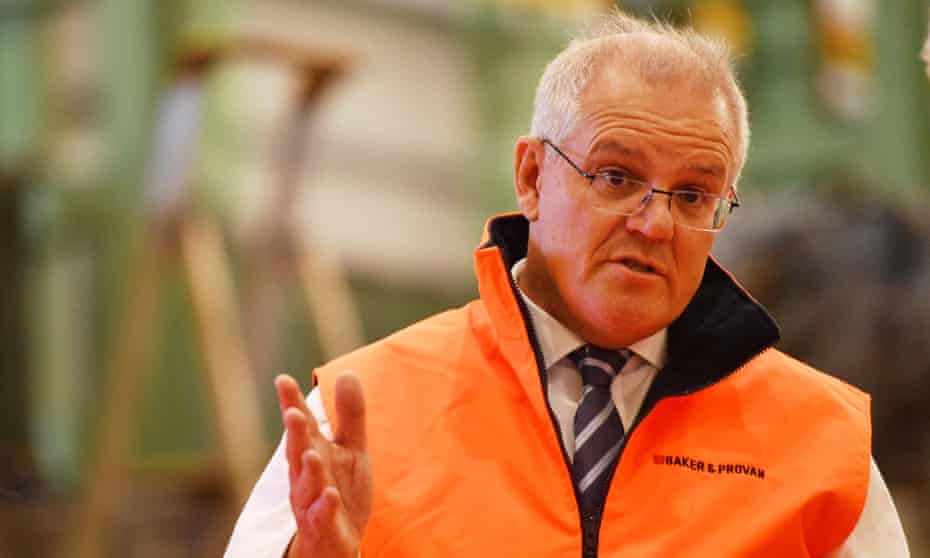The planet is on the clock and Australia has an inexplicable position on climate – it really isn’t funny

Morrison government can’t lie to all the people all of the time without devaluing its currency

When it comes to climate policy, it’s never prudent to say we’ve hit peak preposterous, because this is Australia. There are always new depths to plumb.
But we were certainly peak preposterous adjacent on Monday when Scott Morrison and Angus Taylor attempted to explain why Australia had just signed a commitment to look at its 2030 emissions reduction target – but our target wouldn’t be changing because it was both immutable and completely redundant.
Barnaby Joyce then compounded the disorientation later in the day by suggesting “the Nationals” (a core part of the Morrison government last time I looked) had not signed up to anything at Glasgow.
Given Morrison and co have now flicked the switch to election campaign mode – and, when it comes to climate, the pressing objective seems to be (borrowing from Steve Bannon) to flood the zone with shit – let’s step through the relevant facts.
Before we get to Monday’s word salad, we need to understand some recent history.
In the run up to Cop26 in Glasgow, Morrison attempted to increase Australia’s 2030 target. Joyce said no, so Morrison went to the summit with nothing formal to say on 2030. Australia was the only major developed country that refused to increase its 2030 emissions reduction targets.
The Glasgow summit was focused on 2030, so Morrison attempted to step around his problem by talking up a projected over-achievement on the Abbott-era commitment of a cut of between 26% and 28%. He hoped that would suffice.
But despite Australia’s heroic whoosh whoosh offensive, Glasgow remained resolutely focused on 2030. The final communique of the summit had countries agreeing to re-examine and strengthen their existing 2030 goals when they return to the negotiating table at Cop27 in Egypt.
The communique contained the caveats generally required to get communiques over the line. Countries (being sovereign states) were requested to revisit and strengthen their 2030 targets, and naturally these commitments should “take into account different national circumstances”.
But the spirit and intent was clear. The planet is on the clock. Let’s all come back at the next gathering and do a bit better.
Given the 2030 target remains a lightning rod inside the Coalition, Australia wasn’t exactly thrilled with a commitment to revisit the same problem at the next United Nations-led summit.
But we signed up.
Voluntarily.
Then very shortly afterwards, Australia said the complete opposite. Two portfolio ministers issued a statement in the hours immediately afterwards declaring Australia’s 2030 target was “fixed”.
Before anyone had time to scratch their heads about the duelling realities – one domestic and another international – Monday dawned. Morrison was asked to explain Australia’s position, given Australia’s position is now officially inexplicable.
Morrison played down what we’d agreed in the final communique. That was just a “request”. He said he’d been clear about “what our target is” – just for clarity, this would be the target the prime minister had tried and failed to change.
We would be sticking with the target (that the prime minister had tried to change only a few weeks ago) because consistency was important. But even more important than sticking with this immutable target was the fact Australia’s immutable target was now completely redundant.
“See, we are going to achieve a 35% reduction in emissions by 2030,” the prime minister said. “That’s what we’re going to achieve and that’s what actually matters.”
The prime minister was then asked the obvious question. “Why don’t you make that your target then, if you’re going to get to 35% anyway?” Morrison replied: “Because our policy is to meet and beat – that’s what we do.”
So here is the logic we are being asked to accept: Australia won’t make our current 2030 target more ambitious (even though we held out that prospect at the end of the Glasgow summit) because the prime minister tried to do that a few weeks ago and Barnaby said no; and, in any case, we will overshoot that stupid target anyway even though Barnaby says that target can’t possibly increase (because the Nationals want to win seats in the Hunter valley.)
This logic is the equivalent of an ad-hoc home renovation where everything is so unwieldy you end up with a bidet in the living room, and everyone just tiptoes around trying not to notice the inexplicable bidet – because if anybody acknowledges you have a bidet in your living room then nothing makes sense any more, and then you comprehend the only thing that can fix your botched renovation is a detonation so large it could wipe out a whole neighbourhood.
Just in case the fundamentals aren’t clear, let’s be clear. If Australia signs a communique saying we will have another look at our 2030 target, we should either have another look at our 2030 target, or not sign the communique.
Seriously. You can’t lie to all the people all of the time without significantly devaluing your currency either with peers and allies abroad – or with voters at home.
Also: One. Targets are an integral part of the process of successful emissions reduction, as are policy mechanisms driving the necessary abatement. At the moment we have a fungible medium-term target, and instead of a policy, we have a pamphlet.
Two. When it comes to 2030, Australia has not achieved anything at this point. We haven’t achieved a 35% cut, the government has forecast Australia might achieve a 35% cut, while our actual 2030 target (which can’t change and is also completely redundant) remains a cut of 26 to 28%.
You’d laugh if this was actually funny. But it really isn’t funny.